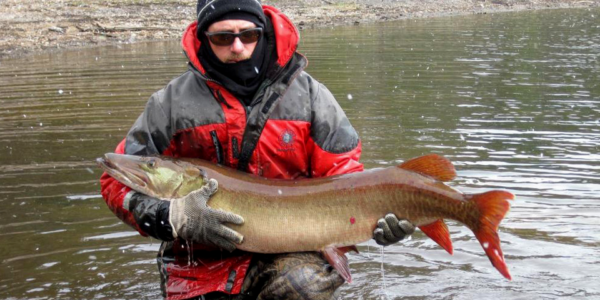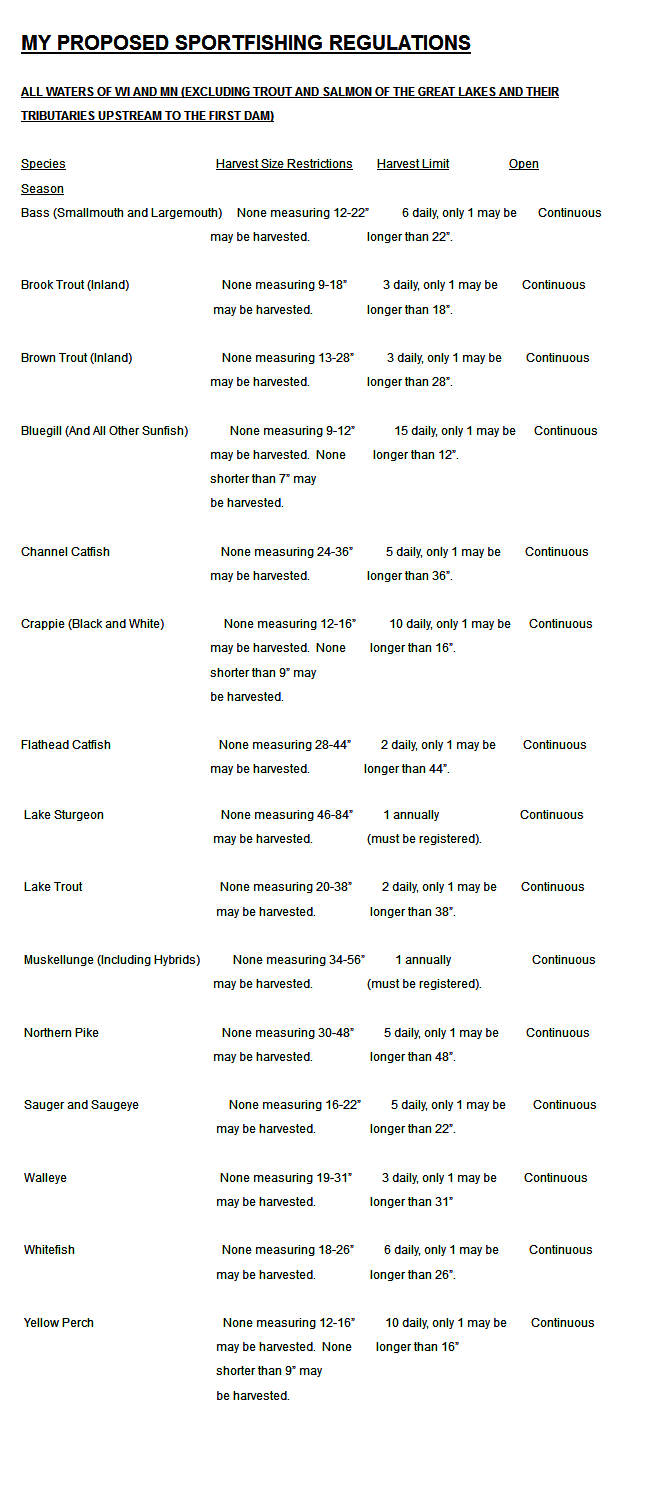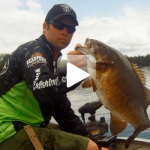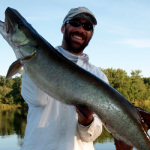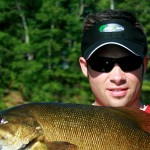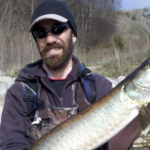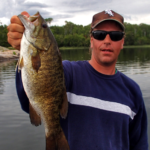What proper regulation looks like and why it would work.
By Adam M. Glickman
In part one of this article I promised a simple streamlined regulatory plan that would work state wide in both Minnesota and Wisconsin. That plan is contained within this article, as well as an explanation of everything within it. If you were not a subscriber on 3-1-17 when the first part of this article was published, and you want to read it, email me at adam@honestmusky.com and I will send you the March issue (containing part 1).
Even though stocking comprises a large percentage of the fisheries budget in both MN and WI, most of our gamefish populations are self-sustaining. WI and MN each spend millions of dollars every year gathering reproductive material, hatching, raising, and stocking walleye, musky, trout, and salmon; and to a far lesser extent bass, panfish, pike, and catfish. Most of our gamefish perpetuate themselves for no more than the cost of maintaining healthy waterways and making sure there are enough sexually mature adults to reproduce a healthy large population of said species. In other words, it is most cost effective to rely on and properly maintain our naturally reproducing populations of gamefish. However, stocking creates and maintains populations of heavily sought after gamefish that drive economies on regional and state levels, and are thus economically viable to artificially perpetuate. In either case, waterbodies that maintain large numbers of adult gamefish are not only healthier, but also create greater economic draw. Bolstering our gamefish resources has intrinsic, social, environmental, and economic value. The following streamlined and simplified regulations would accomplish this within 6-20 years (depending on waterbody and species), and likely on the lesser end of that timeline. Following the regulations, will be an in-depth explanation of why I think they would be beneficial.
MY PROPOSED SPORTFISHING REGULATIONS
ALL WATERS OF WI AND MN (EXCLUDING TROUT AND SALMON OF THE GREAT LAKES AND THEIR TRIBUTARIES UPSTREAM TO THE FIRST DAM)
- Fish must be measured on a flat surface in a straight line from the tip of the snout with the mouth closed to the end of the compressed tail.
- All fish not meeting all lawful harvest requirements must be immediately and safely released unharmed back into the water from which they came (special tournament permits will be liberally issued at no charge, providing all fish handling and transportation requirements are met).
- Harvest limits are per person. Daily means every 24 hour calendar day. Annually means every 365 day calendar year. Possession limits are the same as daily or annual harvest limits for all species.
- All fish requiring harvest registration must have a clear photograph/picture of the fish next to an accurate length measuring device (in inches) accompanying the valid fishing license ID # of the angler in possession of said fish emailed or texted to the appropriate email address or phone # within 24 hours of the catch.
- Party fishing is allowed, but no more than 4 individual harvest limits total may be kept in one party limit.
- No 1 angler may use more than a combination of 3 lines or three baits/lures per person all year round (for example: 3 lines each with 1 lure or 1 line with 3 lures), motor trolling legal, no bait or lure restrictions except non-native species may not be used (ie goldfish/carp).
EXPLANATION
These regulations are designed to protect large sportfish that are also sexually mature adults. Protecting these fish with a slot limit will create huge amounts of individuals to reproduce new generations in staggering amounts. They will also support a catch and release sport fishery that will be second to none. Continuous seasons for all species, combined with huge numbers of large gamefish of all available species will turn WI and MN waters into some of the most popular year-round sport fishing destinations in the world. Our economic gain from sport fishing revenue would increase exponentially from its current level. There is little evidence that angling pressure affects spawning activity, especially when all large adult fish are strictly protected from harvest. High densities of vulnerable spawning fish in certain areas are already protected by refuges, this should continue. Heavily protected year classes of larger fish, after 3-5 years, would increase the amount of eater size fish and increase the ease of their harvest. Just to clarify, all anglers will eventually be able to take home more pounds of quality fish every year than they do now, given equal expenditure of time and money. Again, noticeable improvements will take years. Depending on species and environment, top end potential sport (catch and release) fishing and harvest angling will be available within 6-20 years; with many sought after “table fare” species such as panfish, walleye, and pike on the shorter end of that range of time.
BASS
Bass, both largemouth and smallmouth bass, are perhaps one of our most valuable gamefish resources. The only fish more sought after in the U.S. are panfish, however bass provide a larger economic industry. In MN and WI, largemouth bass keep local and visiting anglers interested and occupied, and drive a healthy sport and tournament based economic draw. However, our smallmouth bass populations draw anglers from across the country. Southern U.S. anglers, who would not travel north to fish largemouth bass, long for the opportunity to fish quality smallmouth bass waters.
One of the best smallmouth bass resources in WI and MN, Mille Lacs, gained much positive attention during the Bass Master Elite Angler of the Year Championship in September of 2016 when large numbers of huge smallmouth were weighed in. What many don’t realize is that the Mille Lacs smallmouth resource at that point had been in decline due to regulation changes and massive harvest. Prior to 2014, Mille Lacs smallmouth were protected by a 21” minimum size limit. When problems with the walleye population arose and walleye harvest quotas were slashed, the protective limit was lifted to appease anglers clamoring for more harvest. In 3 seasons, an epic sport fishery that took many years to build was substantially reduced. This is arguably yet another epic blunder involving gross fisheries mismanagement.
If properly promoted and managed, the Mille Lacs smallmouth resource could have brought in economic draw equal or greater to that of the walleye, and could have saved and even bolstered the local resort and sport fishing industry until the walleye resource could be brought back. Instead, the epic nature of the smallmouth population was sacrificed in the name of 3 seasons worth of fish fries. This is short sighted to say the least. I also want to add that the Mille Lacs smallmouth fishery and resource is still excellent, even though it is a shadow of what it was. If it were properly regulated again (as I am proposing), it would bounce back after several years. However, the reckless harvest is still on, so who knows what will become of this resource.
Bass are self-sustaining to the point that any stocking efforts of the two species are a waste of money. Smallmouth and largemouth bass are so prolific that thinning out young year classes is usually necessary to keep growth rates of adults high and prevent stunting. This opens up a wonderful opportunity to harvest smaller bass (which taste just like bluegill). My proposed bass regulation would work on all MN and WI waters and would be a win across the board. Large fish will be protected for sport anglers and for reproduction, a huge fish could be kept as a trophy or for record purposes, and those looking to harvest fish will have huge numbers of healthy (small young bass are extremely low in mercury), tasty, and easy to catch fish at their disposal. Small bass are an underutilized resource. In many areas, ridiculous minimum size limits prevent their harvest altogether and promote the harvest of larger reproducers. Misconceptions have lead people to believe they don’t taste good. In the summer, the fillets can be soaked in milk overnight to remove any off flavors (this works on all other species as well). Once all laws allow for the harvest of small bass, and popularity makes it common practice, harvest of small bass will take some of the total harvest pressure away from hard hit panfish and walleye.
BROOK TROUT
Many of the streams of WI and MN are home to arguably the best brook trout resources and fisheries in the U.S. They reproduce naturally in most of the streams in which they reside, populate in high numbers, and have fair growth rates. Brook trout are gorgeous, tremendous sport fish, and an extremely healthy resource with large individuals will attract sport anglers from across the country (economic draw). Are our streams ever going to produce the 4-6 monsters of Manitoba, Ontario, Quebec, and eastern Canada? I think it is unlikely, but I do think 18-20” specimens are a definite possibility in some streams. In healthy environments, brookies live to 14 years of age, and they need to be allowed to live this long to reach large sizes not only for the enjoyment of fishermen but also because large individuals reproduce more successfully and pass on the best genetics, improving growth rates in subsequent generations. Brook trout are also delicious (especially wild ones) and should be utilized as a harvest for food resource as well. My proposed regulation would allow the harvest of eater sized fish (of which there would be many when the big spawners are protected), protect the best reproducers and sport fish, and allow the harvest of a trophy or record fish.
BROWN TROUT
Brown trout are also an excellent, naturally sustaining resource of our streams and rivers. Many have the potential to reach trophy size, but few ever do due to harvest. Brown trout are short lived (rarely exceeding 8 years) and grow rapidly in certain environments. Under my proposed regulations, all inland waters would see near their maximum size potential in 5 years. After that, the maximum potential size would creep up very slowly for several years as larger and larger browns would dominate reproduction, passing along superior genetics, and therefore increasing growth rates in subsequent generations. This would also increase the overall number of fish, which is also fantastic because smaller browns are excellent to eat. Again, my proposed regulations would accomplish the best of both worlds. My proposed trout regulations also completely streamline and simplify current trout regulations in WI and MN, which are in desperate need of streamlining and simplification. Currently, they are in fact so complex that they cause many potential anglers to shy away from experiencing and utilizing these amazing resources. My proposed regulation would bring in more out of state money and increase DNR trout budgets due to increased trout stamp sales.
CATFISH
Channel and flathead catfish are prolific and very underutilized resources in WI and MN; but they grow very slowly, live in excess of 25-35 years, and large adults should be protected for sport, reproduction, and proper balance among species. Both species make excellent table fare, yet they are largely ignored by most WI and MN anglers. There are many misconceptions in MN and WI regarding the eating quality of catfish, but anyone who has been to the southern U.S. knows they are a staple there and delicious. They taste just as good north of the Mason Dixon Line, and surprisingly their populations are often healthier up here because pressure on them is comparatively much lighter.
At a relatively small cost, multi-media sources and family orientated catfish fishing and eating events could promote the catfish as the quality food harvest fish that they are. Once successful, such campaigns would balance harvest pressure across more species, alleviating some pressure from more heavily impacted species such as panfish and walleye. The sporting value of large catfish is also second to none, anyone who has hooked even a moderate size catfish knows this first hand. My proposed regulations would protect large adults for sport and reproduction, and help produce large numbers of “eaters” for people looking to easily catch a great meal of fish.
LAKE STURGEON
Lake sturgeon are the largest fish in MN and WI and an amazing sportfish. Pound for pound, their fighting and leaping ability combined with their stamina puts other gamefish to shame. When one realizes that these fish often reach sizes of 50-150 lbs., it becomes clear that promoting these titans as a sport industry to draw sportsmen from great distances would not be that difficult of a task. Sturgeon, though large, are also prolific in spite of taking many years to reach sexual maturity. Once harvested to the brink of extinction for food as well as fuel (it was discovered their dried oily carcasses burned hot and long in wood stoves), sturgeon have made an amazing comeback in many lake and river systems. So much so, that a spearing harvest season on the Winnebago/Fox River/Wolf River system allows for the annual harvest of roughly 2000 individuals with no real detriment to the overall system. Yet, no hook and line angling season is ever open on that system, not even for catch and release. Some other systems also offer no open season. Others, very limited seasons, which promote the harvest of larger specimens by the use of minimum size limits. Allowing anglers to fish for lake sturgeon year round on all waters, while protecting large old fish (which take 15-25 years to become sexually mature), would allow the species to continue to flourish and expand into new waters. This industry would create huge economic benefit, part of which could in turn be used to create new sturgeon populations and bolster those existing, the same as what is currently done with revenue created by the Winnebago spearing. My proposed regulations could easily accomplish all of this.
LAKE TROUT
Lake trout are indigenous to the deep cold lakes of WI and MN. They grow very slowly and live up to 40 years. Lake trout regulations in WI and MN are fairly restrictive, yet fail to properly protect the large adults necessary to maintain a robust population. Lake trout attain large sizes, and are excellent sport fish. They are also excellent eating. Allowing anglers to keep small fish while releasing the larger ones to reproduce and provide continued sport fishing opportunities is the best way to manage this resource. Minimum size limits or no size limits do not work, especially on fish that grow as slowly as lake trout. Once large reproducing fish are protected, there will be no need to have closed seasons to protect spawning, because spawning size fish will be protected any way. My proposed regulations would increase the population of large lake trout, providing excellent sport fishing opportunities, and in turn the increased number of larger fish will make more young fish increasing the opportunity to harvest delicious lake trout for a meal.
MUSKELLUNGE
The muskellunge is a very important gamefish species in WI and MN. They attain large sizes, are very elusive, and strike large lures (often in a very visual manner). Catching muskies is extremely exciting, even for seasoned veterans. Musky fishermen are not as numerous as walleye, bass, or panfish anglers; but they are willing to spend comparatively large amounts of money on their pursuits. Most WI musky opportunities are better than I can remember them being in the last 20+ years, but other destinations are producing better action and thus get much more attention. What tribal and state government officials in MN and WI consider to be good musky fishing (and therefore set harvest quotas by) is a joke and not at all competitive with standards now being set in other “musky” regions of North America.
Musky populations in the waters of MN boomed between 2002-2012, but many of these resources have recently gone into decline due to lack of stocking, mishandling, and spiteful killing. Many of these waters are not the popular destinations they once were, and thus local economies are seeing much less economic draw. MN musky resources that still have strong numbers are seeing a large increase in pressure, as anglers search out better opportunities to replace those that have become poor. The increase in pressure on strong populations has caused fishing to become poorer as muskies become warier of boats, people, and lures. Of course, this has also caused traveling and in state anglers to seek other destinations, creating two-fold economic loss. Examples of other destinations that WI and MN loose musky anglers to are Lake St. Clair in lower Michigan and the lakes of Ontario just across the MN border. These waters are thriving and putting out lots of muskies and big muskies too.
Our musky waters in WI and MN have the potential to have greater economic draw than anything that is out there (even those that are currently pulling more). WI and MN have a greater diversity of musky waters than anywhere else in the musky’s range. We have muskies inhabiting natural lakes that range in size from <100-220,000 surface acres. These waters range in cover and structure type from shallow and weedy to deep with shield rock structure similar to that of Canadian lakes. Our muskies live in flowages and reservoirs that run <100-23,000 surface acres. Between the two states, muskies inhabit over 100 streams and rivers adding up to literally thousands of miles of diverse habitat ranging from streams that are no more than 5 yards wide to large rivers nearly a mile across in areas. Western Ontario has waters nearly as diverse, but if U.S. anglers had better populations south of the border in WI and MN to choose from, many of them would go to (or stay in) WI and MN instead of going to Canada. By doing this, they could avoid border crossings, extra travel time, and extra travel expense. WI and MN destinations are way more convenient than those in Ontario, and they are all capable of producing musky fishing of equal quality to those in Ontario, if they are regulated properly under my proposed regulations.
Booming Lake St. Clair now takes a huge portion of musky travelers from Chicago, travelers that mostly used to go to WI and MN. The vast musky population and huge individuals of Lake St. Clair are difficult to compete with, but productive strategies there are usually limited to trolling, vertical jigging, and deep water casting. On the diverse musky waters of WI and MN however, the sky is the limit in terms of choice in tactics. Most of the year, on many MN and WI waters, shallow and topwater casting presentations are often the most effective; and many anglers prefer to be on waters that are more conducive to these more visually exciting and engaging tactics. However, the numbers and size of fish have to be there, and that is what my proposed regulations would accomplish.
Highly protective musky regulations, such as those with extremely high minimum size limits, often meet resistance from those who want to maintain the ability to harvest a musky to eat. My regulations would allow any angler to harvest one smaller musky per year to eat. Larger muskies are very high in mercury content and thus are not healthy to consume. Encouraging people to keep larger muskies to eat and/or allowing a single individual to harvest many muskies per season is gross mismanagement. It is fine for a person to keep a small musky to eat or a family to keep a few small muskies to eat. A huge fish for a trophy or potential record is also acceptable. Excellent (and longer lasting) replicas can be made for trophies that fall in the proposed protected slot limit. What is not OK is one angler keeping many fish per season. It destroys any resource as well as the benefit of the careful conservation practiced by the majority of musky anglers.
Selfishness and misuse should no longer be allowed. At the “spring hearings” in WI on Monday 4-10-17, the public (from any state) will be allowed to vote on the question of a musky tag that would allow each angler to harvest 1 musky per year, requiring the use of a tag. This is a huge step in the right direction not only for protecting the resource, but also in getting an accurate count on legal sport harvested muskies. An accurate count will help when discussing harvest quotas with tribes who have usufructuary fishing rights in some of the ceded territories. This is long overdue, as muskies are rare and other rare fish (such as lake sturgeon) have benefited from such regulations for years. On many waters inhabited by both species, muskies are now rarer than lake sturgeon, so the harvest limit only makes sense. The spring hearings take place in every WI county on the evening of Monday the 10th, so if this issue is of any concern, please get out and vote. It will make a difference. For more information on times and locations, google “WI DNR Spring Hearings”.
Many MN waters have gone into decline due to decreased stocking efforts, however just a small portion of the increased economic draw would easily pay for increased and perpetually maintained stocking efforts. WI has a larger stocking effort than MN, but it could still be better. Money spent on increased musky stocking effort (in both states) would pay for itself many times over in 5-10 years, if my proposed regulations were put into place and the improvement of the resource were properly promoted.
NORTHERN PIKE
Northern pike have the advantage of being an aggressive sport fish, a quality food fish, and a prolific reproducer. Northern pike are another one of the most mismanaged gamefish resources in all of WI and MN. They are stocked in some waters, but this is a waste of money as they naturally inhabit thousands of waters in MN and WI, and would flourish if properly regulated under my proposed regulations. Minimum size limits on pike are a farce, because they promote the harvest of larger fish with better genetics and sporting quality. They also cause an over-abundance of small fish which usually leads to stunting and the succession of inferior genetics. Smaller pike are better to harvest, because they are safer to eat (less mercury volume within their flesh). Since pike are so prolific, thinning out year classes early increases growth rates of every year class going forward and thus pike attain much larger sizes. My proposed regulations would protect large mature adults to expand sporting opportunities and increase reproduction, in turn creating more harvest opportunities for anglers to easily harvest a great meal of fish in a short amount of time. Pike are so aggressive that larger fish need to be protected in order to reach their full size potential. Most WI and MN pike waters are capable of producing fish >10 lbs., and many are capable of producing 20+ lb. giants. However, almost none of our pike waters are reaching their full trophy or harvest potential. My regulations would allow this to happen. Current WI and MN pike regulations will not accomplish this. The proposed new pike regulations in MN that will likely take effect in 2018 will also not bring pike waters to their fullest potential. Said regulations are complicated, including 3 management zones and some minimum size limits. They are probably a step in the right direction, but they are also ridiculous.
SAUGER AND SAUGEYE
Sauger inhabit fewer waters in WI and MN than do walleye, but in the waters in which they reside, they are prolific. Saugers run smaller in size than walleye, but they are excellent to eat and could provide a better sport and food resource than they already do. Again, this could be done by protecting larger fish for reproduction and sport, which would in turn provide more smaller fish to keep and eat. My proposed regulations would accomplish this. The hybrid saugeye should be regulated with the sauger.
WALLEYE
Walleye are one of the most pressured sport fish across WI and MN, and the vast majority of their populations are extremely stressed due to this pressure. River spawning walleyes are our most resilient populations, as most river populations are capable of successful natural reproduction and they are less prone to bad reproductive year classes than are lake spawning walleyes. MN and WI have more walleye waters (usually lakes) with little or no natural reproduction than we do waters in which walleyes sustain themselves through natural reproduction. WI and MN stock more walleyes than any other species, because walleyes are in very high demand and naturally reproduce in only a small percentage of our individual waters. Populations of walleyes, whether perpetuated by natural reproduction or stocking need to be regulated the same for sport and food chain balance. Walleyes are voracious and do an excellent job of thinning out small panfish, increasing the growth rates of stronger individual perch, crappie, and bluegill; insuring that only the strongest survive to reproduce and pass on the best genetics possible. My proposed regulations would fill all walleye waters with big numbers of large individuals, which would draw more anglers and create revenue to increase stocking effort on waters with no or little natural reproduction. The increased stocking effort would allow for more harvest of eater size fish and allow more walleyes to enter the protected size class. In waters with solid natural reproduction, this vast protected class of adult fish would breed huge numbers of young walleyes into the system.
Under my proposed regulations, it is possible that unusually tremendous fishing pressure on certain populations could cause the harvest of so many walleye <19”, that harvestable size fish could become scarce even in the face of huge socking efforts and vast natural reproduction. This however is very unlikely as increased future stocking budgets could allow for vast plantings, and naturally reproducing populations would have so many adults to create gigantic new year classes.
When properly protected, bolstered, and regulated; walleye populations have a tendency to bounce back and improve rapidly. A prime example of this is Red Lake in northern MN. In the late 90’s, decades of massive tribal and sport angler over-harvest destroyed one of the state’s most vast walleye populations. However, a moratorium on harvest and a massive stocking effort showed tremendous results in as little as 3 years. Three years after that (in 2006), harvest resumed; and today tribal harvest quotas are over 800,000 lbs. annually and over 100,000 lbs. annually for sport anglers, for a total of nearly 1,000,000 lbs. per year which is considered “safe”. This is a classic example of both how resilient our natural resources can be and how people don’t learn from their mistakes. Red Lake is vast, fertile, and home to both lake and river spawning walleyes; but to think that it is capable of giving up near 1,000,000 lbs. of walleye every year and not eventually fall victim to the same greed as before is foolish and ridiculous, especially with little to no protection of large reproductive fish.
To put things in perspective, if the Red Lake Ojibwe tribe harvested only 500,000 lbs. of their annual quota, that would equate to roughly 100 lbs. of walleye every year for every man, woman, and child Red Lake tribal member. It seems unlikely that this is necessary, and furthermore it is misuse and misallocation of an extremely lucrative resource that is sorely failing to live up to its full financial potential. The Red Lake tourism industry has never seen near what its peak potential could be if the walleye resource weren’t being squandered as it was and continues to be. The value of a ridiculous amount of meat on the table and even commercial sale of Red Lake walleye pales in comparison to the economic value that lies in the potential Red Lake tourism/sport fishing industry.
There are almost no communities in our country that are not connected to the global economy; and the strength of these communities in almost every way is connected to their economic strength. Honoring traditions and culture are important, and the people of Red Lake should absolutely observe these practices, but advisedly on a much smaller scale. Practicing large scale harvest while ignoring the potential revenue of tens of millions of sport fishing dollars annually is short sighted to say the least. The number of anglers in the upper Midwest who would love to stop at Red Lake instead of venturing on into Canada is staggering. Revenue gained from sport angling alone would be huge, not to mention the heavy increase of traffic through tribal casinos. The Red Lake tribe would have every right to open up their portion of Red Lake to anyone they see fit and essentially sell a portion of their harvest quota to sport angling tourists. This would include selling permits and opening many large lodges open year-round (which could all include gaming). The potential revenue is gargantuan compared to anything the resource is producing now. Proper regulations (such as those I propose) would create huge numbers of trophy fish as well as a gigantic population of eaters; creating a walleye fishing mecca and a win for everyone.
WHITEFISH
The lake whitefish has become very popular with anglers on Lake Superior, Lake Michigan, and certain inland waters. They are delicious and often plentiful. The resurgence of lake whitefish in the Green Bay of Lake Michigan over the last decade has created a vast economic draw to the area. However, at the rate and manner in which they are being harvested, the resource is unlikely to last, but it could. Again, my proposed regulations would protect large adult spawning fish to ensure robust year classes and healthy populations for years to come. What is happening now is essentially a free for all, and free for alls usually only end one way.
PANFISH
I am discussing bluegill, crappie, and yellow perch together; as the benefits of my proposed regulations would be very similar for each and therefore mentioning them separately would be redundant. Panfish are the most popular species among anglers nationwide and MN and WI are no exception. Greatly improved panfish populations would substantially increase out of state money flowing into MN and WI and retain in state money that we are currently loosing to states with stronger panfish populations, such as the Dakotas. Panfish populations are perhaps the most renewable resource of all MN and WI species that are popular as table fair. However, the ability of these resources to consistently put out good numbers of “keeper” size panfish has been greatly diminished due to mismanagement and misuse. In turn, much unnecessary added pressure has been put on other species such as walleyes, which everyone knows have been getting hit quite hard in recent decades.
The biggest hurdles to the public accepting these proposed regulations are that each fish will need to be measured, for about 3 years harvestable fish will be somewhat scarce (which they are now anyway), and that the “jumbos” will mostly need to be released. However, within 3-10 years, anglers will be able to go out on most waters and easily catch limits of 8”bluegills, 11” crappies, and 11” yellow perch on a regular basis. On most waters, this will happen in closer to 3 years than 10 years. A short wait and a little time spent measuring fish is a much better scenario than MN and WI panfish anglers are currently facing.
Currently, what usually happens, is a lake produces a bumper crop of good sized panfish, anglers flock to it, it gets “fished out”, and it takes years to recover (if it ever does). The other scenario are lakes that consistently have small numbers of good size panfish, and some anglers can regularly scrape together small meals of good size fish. The waters that consistently produce large numbers of big panfish are presently almost nonexistent; sadly, if regulated properly (my proposed regulations), almost all waters have the potential to do just that. It is true that all panfish populations can be cyclical, but under my proposed regulations these cycles would be much shorter and less severe. Natural cycles caused by cannibalism and rare bad reproductive year classes are much less noticeable than those caused by severe over fishing. Some may argue that protecting smaller panfish and the largest panfish will cause stunting, but with my proposed walleye, bass, pike, musky, and catfish regulations; the abundance of larger predatory fish will keep panfish numbers well in check. Also, these larger gamefish will in fact need larger numbers of small panfish to keep their growth rates up. Waters that need more large gamefish to keep huge numbers of small or “stunted” panfish in check will take longer to balance out. This is yet another potential win across many categories that could be provided by proper regulations (the ones I have proposed).
These panfish regulations will work in all waters of WI and MN. The only exception being small winterkill lakes that never have much for larger gamefish in them. Usually, in these waters, fertilized crappie and bluegill eggs end up being transported by aquatic birds or a few survivors end up repopulating a water, 3-5 mild enough winters occur consecutively, and a decent crop of panfish then exists. In rare cases, they populate to heavily because the hatches were too successful, no gamefish existed to thin them out, and no loons or cormorants found them to thin them out. In this type of scenario, my proposed regulations would not work, but this is by far the exception not the rule.
TRIBAL HARVEST (INCLUDING ROUGH POSSIBLE GUIDELINES FOR REFORMED TRIBAL HARVEST)
- No more than 1 lb. of muskellunge per 10 surface acres may be harvested annually (all methods combined) from any given lake in the ceded territory (voluntarily on reservation waters).
- No more than 1 lb. of walleye per 5 surface acres may be harvested annually (all methods combined) from any given lake in the ceded territory (voluntarily on reservation waters).
- No more than 1 lb. of other gamefish combined per 5 surface acres may be harvested annually (all methods combined) from any given lake in the ceded territory (voluntarily on reservation waters).
- No more than 3 lbs. of muskellunge per river mile may be harvested annually (all methods combined) from any given river or stream in the ceded territory (sections of the same river or stream divided by dams will be considered separate water bodies) (voluntarily on reservation waters).
- No more than 6 lbs. of walleye per river mile may be harvested annually (all methods combined) from any given river or stream in the ceded territory (sections of the same river or stream divided by dams will be considered separate water bodies) (voluntarily on reservation waters).
- No more than 6 lbs. of other gamefish combined per river mile may be harvested annually (all methods combined) from any given river or stream in the ceded territory (sections of the same river or stream divided by dams will be considered separate water bodies) (voluntarily on reservation waters).
EXPLANATION
The tribal harvest is a difficult activity to regulate and still be fair to the treaty rights agreed upon by the tribes involved and our government, rights later upheld by the Supreme Court of the United States. Technically, the states do have a right to step in to ensure management that “provides for the regulation of their members in accordance with biologically sound principles necessary for the conservation of the species being harvested.” However, nobody has really defined exactly what “sound principles” and “conservation” mean in this context. Do they mean limping along a shadow of what our gamefish resources could be because we are all greedy and can’t seem to get along with one another? Or do they mean we should work together to build something great and improve all of our states’ various communities in the process? I certainly like the latter notion much better. Certain current tribal practices allow for far too much exploitation. For example, tribal harvest of lake sturgeon is tightly regulated. However, musky harvest regulation as nearly nonexistent, literally almost unlimited in some cases. Yet, in many waters where both muskies and lake sturgeon are present, muskies are the rarer of the two species. So why is one rare fish largely protected, when another (that is rarer in many cases) is open to the possibility of essentially limitless slaughter?
I am not a tribal member, so I cannot be sure what is more important to a tribal member: Harvesting as many fish as possible and just barley keeping gamefish populations from collapsing, or economic gain and experiencing populations of gamefish the likes of which have not been seen in MN and WI since the early 19th century? As a sport angler, I would certainly pick the latter. Tribal harvest restrictions such as those I have laid out are restrictive, but there are many waters for the tribes to utilize. If greater harvest is desired, tribal harvesters would have to simply fish more individual water bodies or spread out individual harvesters across different bodies of water. This would disperse tribal harvest out across many waters, allowing the resource as a whole to absorb this impact in a much healthier manner. Once tribal harvest quotas are met, of course tribal members would be welcome to join the sport harvest just like any other WI or MN citizen.
I would like to see the sport harvest regulations I have proposed passed as law. I would like the tribes to use guidelines at least similar to the ones I proposed voluntarily. I don’t want to see anything unnecessarily forced on tribal harvesters. I want us all to choose a better way because it is the right thing to do. Again, everyone would benefit from this.
In our modern world, the healthiest communities are almost always the ones with the greatest economic strength. Going back to the way things were 200 years ago just isn’t possible, no matter how much many of us would like it to. In many ways, I pine for the distant past as well. However, it is just not realistic. I think the best idea is to improve the economic strength of our communities through strengthening our gamefish resources and practicing our respective culture, heritage, and traditions through recreation and ceremony rather than subsistence. The world around us is constantly changing, and grasping to the past too tightly will most often lead to really bad results. The best way to preserve culture, heritage, and tradition is to preserve community quality and pride. As regrettable as it may be, the best way to preserve community quality and pride is through economic strength. My plan can accomplish this, and I would be happy to discuss just how to get it done with anyone interested.
CONCLUSION
The solution really is just as simple as I have laid it out. Of course, many people (mostly political officials, lawyers, and government employees) will say it is not, but it is. Most of the time when someone begins by stating something is “complicated” or “more complicated than that” or “not that simple” is when they are about to lie, covering for a lie, about to try to steal something, covering up theft, or covering up for a mistake they don’t want to own up to. The answer really is as simple as proper regulation and cooperation. It just needs to be given a chance.
These issues are about us all, but more importantly they are about future generations and the legacy we leave long after we are gone. As a father and an uncle who takes the children in my life fishing, I notice that the views and attitudes of children towards gamefish resources reflect those of the adult. Will this generation of children be raised with a sense of conservation or of greed? We will have to wait and see.
I stand absolutely by everything I have proposed in this article. I welcome all comments, questions, arguments, and contestations to anything I have written in this article; and furthermore will publish them (as well as my responses to them) in next month’s newsletter. I will not use anyone’s name, and all I ask is that responses not include profanity, offensive language, insults, or threats. Please email responses to adam@honestmusky.com.
For more content, including video from Honesty Musky Television, Honest Musky Guide Service, Seminar Topics and Availability, and more articles; visit: www.honestmusky.com
Adam Glickman is an independent agent who shops across 9 different A rated insurance companies to best meet your MN and WI home, renters, auto, life, boat, and commercial insurance needs. For more information, contact Glickman at 612-750-0546 or at adam@lcisagency.com


